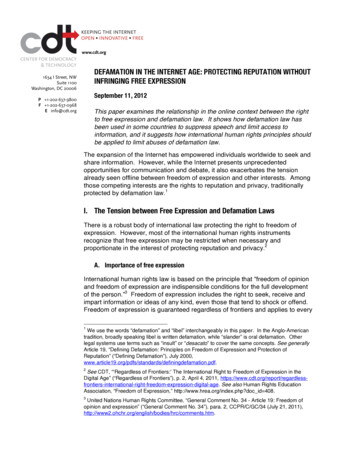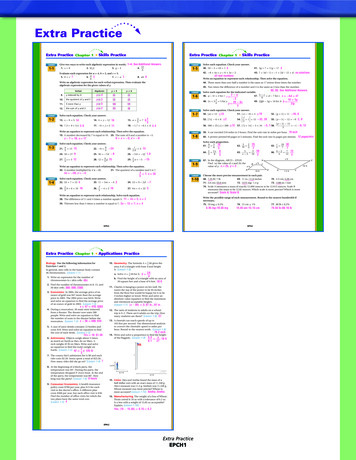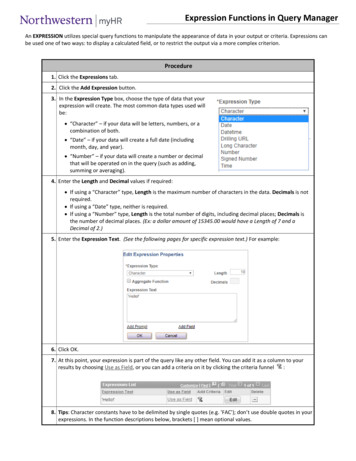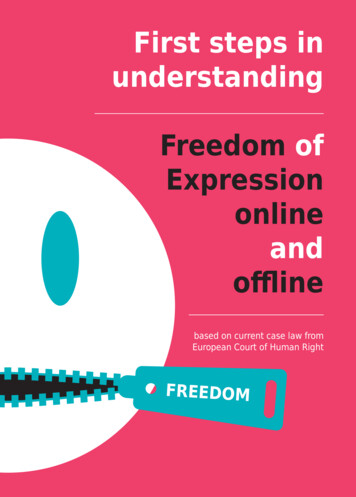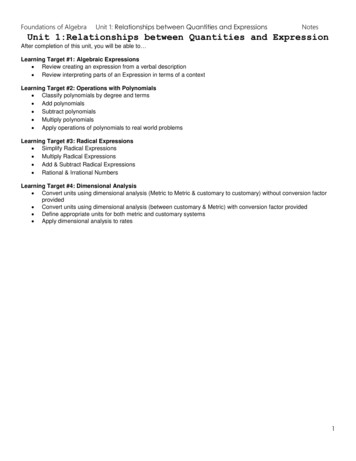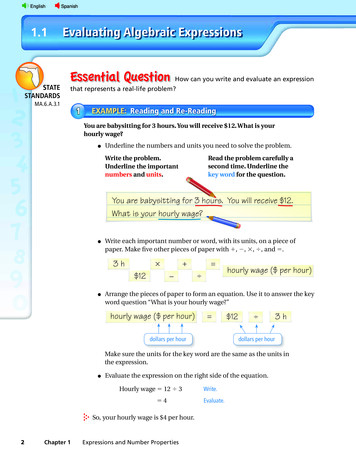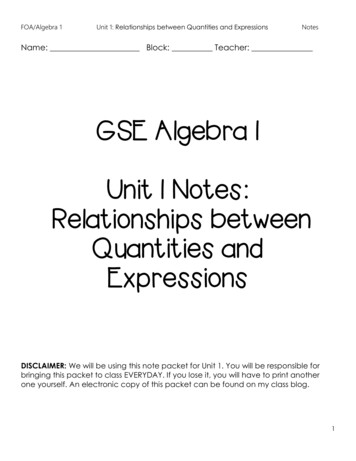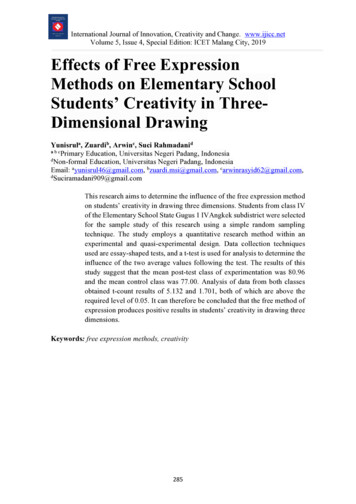
Transcription
International Journal of Innovation, Creativity and Change. www.ijicc.netVolume 5, Issue 4, Special Edition: ICET Malang City, 2019Effects of Free ExpressionMethods on Elementary SchoolStudents’ Creativity in ThreeDimensional DrawingYunisrula, Zuardib, Arwinc, Suci RahmadanidabcPrimary Education, Universitas Negeri Padang, IndonesiadNon-formal Education, Universitas Negeri Padang, IndonesiaEmail: ayunisrul46@gmail.com, bzuardi.msi@gmail.com, mThis research aims to determine the influence of the free expression methodon students’ creativity in drawing three dimensions. Students from class IVof the Elementary School State Gugus 1 IVAngkek subdistrict were selectedfor the sample study of this research using a simple random samplingtechnique. The study employs a quantitative research method within anexperimental and quasi-experimental design. Data collection techniquesused are essay-shaped tests, and a t-test is used for analysis to determine theinfluence of the two average values following the test. The results of thisstudy suggest that the mean post-test class of experimentation was 80.96and the mean control class was 77.00. Analysis of data from both classesobtained t-count results of 5.132 and 1.701, both of which are above therequired level of 0.05. It can therefore be concluded that the free method ofexpression produces positive results in students’ creativity in drawing threedimensions.Keywords: free expression methods, creativity285
International Journal of Innovation, Creativity and Change. www.ijicc.netVolume 5, Issue 4, Special Edition: ICET Malang City, 2019IntroductionFree expression is a method that allows children the freedom to express their ideas orfeelings in the form of art works without being limited by the constraints of technicalprovisions in conventional image creation (Messaris, 1994; Zufrida, 2012). Freeexpression is used to provide flexibility to students to release their feelings into thecreation of art. The process of creating art in this method begins with a determination ofthemes, followed by choosing the content of the expressions and the media, materials andtools with which to create such expression. These factors are chosen in order for studentsto realise various forms of artistic expression and styles, which allows them to producedifferent pieces that are unique to the individual (Chan & Zhao, 2010; Kouvou, 2016)The method of free expression is often misinterpreted as “free drawing” or “drawing atwill”. Educators are still positioned as knowledge sources rather than as facilitators,which often results in the key factors of free expression being ignored ormiscommunicated. Students’ drawings may then deviate from the requirements andcharacteristics of drawing expression (Chang, 2013; Gude, 2010; Kouvou, 2016).Students’ artworks are more likely to fall into the pattern of stereotypes through theproduction of normal images that lack creative development. Such conditions thus allowstudents to become bored or reluctant to take part in fine art education subjects(Desyandri, 2015a; Kouvou, 2016; Runco, 2018).The free expression method is advantageous to the learning process as it encouragesstudents to express their feelings through the creation of art works within the classroom.Students can construct forms of expression that are more in line with their character whileadhering to the themes or principles determined by the teacher. By paying attention tothese advantages, the use of the free expression model can be considered a highlyeffective learning method in stimulating children’s creativity. This artistic form has thepotential to progress students’ arts education and can positively develop their creativeability to express thoughts and feelings through art (Hwang, 2011).Drawing is defined as a human activity to express experiences through visual or mentalforms as represented by lines, shapes and colours. Three-dimensional art refers to art thatrequires space due its measurable features of length, width and thickness (Best, 1982;Niu & Sternberg, 2002; Parnes & Brunelle, 1967). As three-dimensional art does notrequire a flat or non-flat plane, its placement stands freely and does not depend on thebase of walls or platforms, for example statues, architecture and applied arts likehousehold furniture.Judging from its function, three-dimensional art is distinguished into works that have thefunction of use (applied art) or the function of expression (pure art). Differences infunction are determined by the purpose of making the artwork. A usable object that has286
International Journal of Innovation, Creativity and Change. www.ijicc.netVolume 5, Issue 4, Special Edition: ICET Malang City, 2019a practical function and is made with consideration of its usefulness, for example, wouldbe considered as applied art.Creativity refers to the potential of every human being and disregards information orelements that are received from outside the individual (Ku, 2009; Ruggiero & Ruggerio,2004; Zufriady, 2017). Creativity is the process of feeling and observing problems,making guesses, evaluating and testing hypotheses, then analysing those ideas and finallysubmitting the results. Creativity is an inherently human trait, and individuals have showna tendency to actualise themselves even from birth (Alhudhori & Aldino, 2017;Situmorang, 2018). Creativity often results in something new, original and meaningful.An individual’s ability to complete certain motion tasks will directly influence his or herlevel of success; the higher the quality of the task’s achievement, the higher the successof the individual.According to Piaget's theory, elementary school-aged children are entering a concreteoperating period in which their problem-solving, logical and systematic thinking arerapidly developing. The social and emotional conditions of elementary school childrenare still volatile at this stage, however; children are very easily changed and are quick toreturn to their normal state. Elementary school children possess very high ingenuitycharacteristics, which lead to high levels of motivation to learn new ideas and skills(GUO, 2017; Hoover-Dempsey et al., 2005).Elementary school children naturally possess the ability to capture the beauty of natureand art. This capability must be nurtured to ensure its development into creativeexpression. While such abilities vary from child to child, these natural creative tendenciesare one of the most important needs during middle school years (Desyandri, 2015b;Sunarsih, 2017; Tobroni, 2013).The scope of three-dimensional drawing material in K-13-based elementary and MIeducation units is in class IV, theme 8 of sub-theme 3 of learning 5. Three subjects areinvolved in this learning structure, namely PPKn subjects, Indonesian language subjectsand SBdP.One aspect of learning in theme 8 of sub-theme 3 of learning 5 taught in elementaryschool is drawing three dimensionally, which involves students’ abilities to analyse andaccurately draw three-dimensional objects so that creativity can be channelled intoartistic work. Schools that applied the relevant 2013 curriculum were chosen for thisstudy’s sampling. KD 3.1 and 4.1of these schools’ curriculums in class IV of semester IIfeatured three-dimensional drawing in their learning materials and content. KD 3.1involves namely knowing pictures and three-dimensional shapes, while and 4.1 involvesdrawing and forming three dimensions of SBdP learning.287
International Journal of Innovation, Creativity and Change. www.ijicc.netVolume 5, Issue 4, Special Edition: ICET Malang City, 2019Through this material, students can learn to express their feelings in the form of threedimensional images, which fosters creativity related to drawing both in everyday life andin the learning process. Considering the expressions and characteristics of elementaryschool students, it is necessary to determine the most appropriate teaching method toensure properly directed learning and good academic results.The sample population for this study was taken from class IV of the SD Negeri Gugus 1Ampek Angkek subdistrict. Simple random sampling was directly employed on thissampling unit (Margono, 2010: 126), a technique which allows equal opportunity foreach unit as a population element to become a sample.Prior to collating the research sample, the author categorised six elementary schools intogroups of similar characteristics for normality and homogeneity testing. Characteristicsfor this grouping purpose included SDs with the same accreditation and elementaryschools that implemented the 2013 curriculum. Data revealed that five of the six schoolswere normally distributed and homogeneous. Samples were then then split into twogroups according to the design used. Classes with a low average were used as experimentgroups while classes with a high average were used as control groups. The researcherschose SDN 16 Surau Laut and SDN 04 Biaro as samples based on a number of keyfactors: a) limited time, energy and funds which disallowed large or far samples; b)conducting the same teaching and learning activities from morning to afternoon; c) thesame number of class IV students across both groups; d) similar averages in each class,and e) similar student characteristics in each class, as the average student is sourced fromthe adjacent environment.Based on the sampling technique used, the samples in this study were fourth gradestudents of SDN 16 Surau Laut and SDN 04 Biaro. These students were enrolled in theodd semester of the 2018/2019 academic year and totalled 46 participants, evenly splitinto 23 students per class.Sample normality and homogeneity was then determined by conducting a pre-test in bothclasses, the results of which confirmed that both class IV SDN 16 Surau Laut and classIV SDN 04 Biaro were normally distributed and homogeneous. The average results ofthe pre-test for SDN 16 Surau Laut obtained a value of 68.17 and SDN 04 Biaro obtained70.04. Pre-testing before treatment for both experimental and control groups can functionas a basis for determining changes or classes to be treated.The test instrument used in this study was a written description test involving 27questions based on learning indicators. After testing the validity, reliability, difficultylevel and different power tests of this questionnaire, 22 good questions were found to beacceptable for use in the research.288
International Journal of Innovation, Creativity and Change. www.ijicc.netVolume 5, Issue 4, Special Edition: ICET Malang City, 2019Research methodsThis study employed a quantitative research method with a quasi-experimental design.According to Sugiyono (2012), the quasi-experimental design includes a control group,but cannot fully function to control external variables that influence the experiment’simplementation. As seen in Table 1 below, a non-equivalent control group was used inthis study’s design that can be seen in Table 1 below.Table 1. Non-equivalent control group design research design designKelompok Pre- Perlakuan PosttesttestEksperimen O1XO3Kontrol-O4O2This research was conducted in the second semester of the 2018/2019 academic year atSDN 16 Surau Lauik and SDN 04 Biaro, specifically from the fourth week of April to thefourth week of May of 2019. This period involved teaching and learning materials fromtheme 8 of sub-theme 3 of learning 5. An instrument test was conducted on March 16,2019 at SDN 29 Koto Hilalang, followed by pre-testing on April 22 in the control classat SDN 04 Biaro and on May 13 in the experimental class at SDN 16 Surau Laut. Tworesearch sessions were then held between classes, the first with the control class on April24 and the second with the experimental class on May 15. These meetings were followedwith post-testing on April 30 in the control class and on May 23 in the experimental class.ResultsBased on pre-test results, class IV of SDN 16 Surau Laut was chosen as the experimentalgroup and and class IV of SDN 04 Biaro as the control group. Different treatment wasprovided to each group over the course of the research sessions: the experimental classwas taught using free expression learning methods, and the control class was taughtwith conventional learning techniques. The gathered data from each group was thencollated and translated into this paper for analysis, as depicted below.The pre-test values of the experimental and control groups were obtained from thestudents’ pre-test answers provided prior to treatment. This testing was conducted inorder to measure students’ initial knowledge about mathematics in the material relatedto data collection, presentation and processing. The pre-test values for both groups arepresented in Table 2 below:289
International Journal of Innovation, Creativity and Change. www.ijicc.netVolume 5, Issue 4, Special Edition: ICET Malang City, 2019Table 2. Pre-test results for the experimental and control 255.42365.771SD7.448.11Table 2 shows the results of the second pre-test of the class. The lowest values obtainedwere 50 in the experimental class and 52 in the control, while the highest valuesobtained were 85 for both classes. The average value of the experimental class was68.17 and the control class gained an average of 70.04. The median values obtainedwere 70 for the experimental class and 68 for the control class. The model values were73 for the experimental class and 71 for the control class. The variance value of theexperimental class was 55.423 and for the control class was 65.771. The experimentalclass obtained a standard deviation of 7.44 and the control class obtained 8.11. Theseresults indicate that the values for both classes were relatively low and still below KBM.Post-test results for both the experimental and the control groups are depicted below inTable 3:Table 3. Post-test results for the experimental and control erimenX-Min6464X-Max9297X̄77.0080.96290
International Journal of Innovation, Creativity and Change. www.ijicc.netVolume 5, Issue 4, Special Edition: ICET Malang City, 2019Me7779Mo8082σ248.363677.4071SD8.806.96As seen in Table 3, the lowest post-test values obtained were 64 for both theexperimental and control classes. The highest values obtained were 97 for theexperimental class and 92 for the control class. The average values were 80.96 for theexperimental class and 77.00 for the control class. The median value of the experimentalclass was 79 and the control class was 77. The model values were 82 for theexperimental class and 80 for the control class. The variance value of the experimentalclass was 77.4071 and the control class achieved 43.3636. The standard deviation valueswere 8.80 for the experimental class and 6.96 for the control class.From the data and corresponding explanations above, it can be seen that the controlgroup and the experimental group produced increased values after treatment withdifferent learning models. Before testing the hypothesis, the results of the research datawere tested for preconditions, namely the normality and homogeneity test to determinewhether the data obtained is normally distributed and whether it has a homogeneousvariance. The normality test was performed using the liliefors test method. Results ofthe normality pre- and post-tests are presented below in Tables 4 and 5 respectively.Table 4. Normality pre-test resultsDataPretestNLoLtKetEksperim 2 0.1278 0.17 Normaen33lKontrol 2 0.1487 0173 Norma3lTable 5. Normality post-test resultsDataEksperimPostentestKontrolNLoLtKet2 0.147 0.17 Norma3 33 l2 0.115 0.17 Norma3 83 l291
International Journal of Innovation, Creativity and Change. www.ijicc.netVolume 5, Issue 4, Special Edition: ICET Malang City, 2019Table 4 above shows the results of the normality pre-test on both the experimental andthe control groups. As the l-count is smaller than the l-table (0.1278 and 0.1487 0.173)it can be concluded that the pre-test data for both groups is normally distributed. Table5 shows the results of the normality post-tests, showing that the l-count is again smallerthan the l-table (0.1473 and 0.1158 0.173). This indicates that the data across bothgroups is again normally distributed.Homogeneity was then evaluated using the Fisher test, which declares that if the f-countis smaller than the f-table, the data is considered to display homogeneous distribution.Conversely, if the f-count is greater than the f-table, the data is not homogeneouslydistributed. Results of the homogeneity pre- and post-tests of the two study sampleclasses can be seen in Tables 6 and 7 respectively:Table 6. Homogeneity pre-test resultsData StatistikVarianPre-testEksperimen e 7. Homogeneity post-test resultsPost-testStatisticVarianBiggestVarianSmall 60.623.20292Control48.3636
International Journal of Innovation, Creativity and Change. www.ijicc.netVolume 5, Issue 4, Special Edition: ICET Malang City, 2019noteHomogenTable 6 shows that the f-count is smaller than the f-table (1.87 3.20), which confirmsthat both the experimental class and the control class are homogeneous in theirdistributions. Table 7 also shows that the f-count is smaller than the f-table (0.62 3.20)which again declares both groups to be homogeneous.As the above data analysis prerequisite tests obtained the satisfactory research data forboth classes with normal and homogeneous distribution, the next stage of hypothesistesting could then be conducted. This testing was conducted using the t-test at asignificance level of 5% and “df / db n1 n2 – 2” with the criteria namely (t count t table Ha accepted) and (t-count t table Ha rejected). This hypothesis testing wascarried out on the value of the pre-tests in order to determine students’ initial abilitiesprior to treatment. Testing in accordance with the post-test values was also performedto find out whether student learning outcomes were influenced by the given treatment.The t-count obtained through the pre-test results -0.85 and t-table 1.6802 with asignificance level of 0.05 and degrees of freedom (df / db 23 23 - 2 44). This dataindicates that t-count t-table (- 0.85 1.701), which therefore rejects Ho. Studentstherefore have the same or equal ability as they have not received different treatment,meaning that no difference exists between the average pre-test values of theexperimental and control groups.The post-test value of t-count 1.7679 and t-table 1.6802 with a significance level of0.05 and degrees of freedom (df / db 23 23 - 2 44). This indicates that t-count ttable (1.7679 1.6802), which therefore accepts Ha that the free expression methodinfluences students’ creativity in three-dimensional drawing. This is due to the differenttreatments provided to students, which resulted in differences between each group’s theaverage post-test values.DiscussionBased on the implementation of learning with the method of free expression in thematerial drawing of three dimensions, students became more active with one another(Kang, Lim, & Yun, 2015; Sawyer, 2011; Taylor, 1988). Students determined theirdesired theme, media and material for the three-dimensional drawing activities andactively engaged in discovering the reasons and methods of the drawing lessons. Whenexpressing opinions about the theme to be chosen, students were able to think creativelyand imaginatively, thus actively and positively impacting the development of theircreativity (Siddiqui, 2005; Sternberg & O’Hara, 1999; Zakeri, 2009). This study foundthat providing flexibility allows students to express their feelings in educational creativeworks and that through selecting their own theme, students are able to create uniform293
International Journal of Innovation, Creativity and Change. www.ijicc.netVolume 5, Issue 4, Special Edition: ICET Malang City, 2019expressions that are more in line with their character (Forawi, 2016; Gude, 2010; Myhill& Wilson, 2013).Pre-test results show that the experimental class obtained an average of 68.17 with thehighest score of 85 and the lowest value of 50. The control class obtained an average of70.04 with the highest value 85 and the lowest value 52. The results of the pre-test datawere evaluated using the analysis prerequisite test, namely the normality test andhomogeneity test, to determine the equivalence of the two classes. Results of these testsconfirmed that data gathered from both the experimental and control groups werenormally and homogeneously distributed, as l-count l-table and f-count f-table. The ttest was able to be performed on the pre-test data in both classes. From the results ofthe calculation, the obtained t-count -0.85, while t-table (0.05.44) 1.6802. Thisindicates that t-count t-table, meaning no difference was present in the average of bothclasses.Based on the results of the pre-test, the experimental group was chosen as class IV SDN16 Surau Laut and the control group was class IV SDN 04 Biaro. The experimental classlearning was conducted using the free expression method while the control classexperienced conventional learning. Each class received two sessions with theirallocated learning materials during semester 2, theme 8 of sub-theme 3 of learning 5.In addition to assessing students’ knowledge during the learning process, an attitudeassessment was also conducted during mathematics simple statistical material. Thisassessment was merely used as supporting data however, as the data was used as a guideto determine the influence of the learning method (Cheng, 2004; Grad, Kočevar, Krvina,Pureber, & Aleksić, n.d.; Kaba, 1976; Owen, 1998).After receiving the lesson treatments, each class was administered a post-test todetermine changes in students’ three-dimensional drawing abilities. The experimentalclass obtained a post-test average of 80.96 with the highest score of 97 and the lowestvalue of 64. The control class obtained a 77.00 post-test average with the highest scoreof 92 and the lowest value of 64. This data also received normality and homogeneitytesting, results of which indicated that both the experimental and control groups werenormally and homogeneously distributed as l-count l-table and f-count f-table.Following the acceptability of these results, the study’s hypotheses was able to be testedusing the t-test. Hypothesis testing results obtained t-count t-table (1.7679 1.6802),concluding that H 1: µ 1 µ 2. This means there exists a significant influence onthree-dimensional drawing creativity between the experimental class and the controlclass in SDN 16 Surau Laut and SDN 04 Biaro.The results of this study support the research conducted by Ratna (2014) entitled “TheInfluence of Learning Methods Free Expression on Creativity in Drawing Class IV294
International Journal of Innovation, Creativity and Change. www.ijicc.netVolume 5, Issue 4, Special Edition: ICET Malang City, 2019Students at SD Negeri 1 Semarapura.” The results indicate that free expression learningmodels significantly influence the results of creativity in drawing, as demonstrated byclass IV students at SD Negeri 1 Semarapura who have a range of 16.00. Based on thisdescription, the formulation of the proposed problem can also be answered, namely theexistence of the influence of the free expression method on creativity in threedimensional drawing in students of SDN Group 1 Ampek Angkek District, AgamDistrict.ConclusionThe results of observations and research conducted in this study suggest that the discoverylearning model has a positive influence on students’ critical and creative thinking skills.Pre-test data results showed that the experimental class obtained an average of 68.17 andthe control class obtained an average of 70.04. This data confirms that the average controlclass was greater than the experimental class with a difference of 1.87. Post-test dataresults showed the average values of the experimental class and control class were 80.96and 77.00 respectively. This data confirms that the average value of the experimentalclass was better than the average value of the control class.Results of the t-test calculations were t 1.7679 while the t-table at the significance levelα 0.05 was 1.6802. This shows that t-count t-table, meaning that the null hypothesis(Ho) was rejected and the working hypothesis (Ha) was accepted. This fact proves thatthe learning method of free expression has a positive effect on students’ creativity inthree-dimensional drawing as demonstrated by class IV SDN 16 Surau Laut. Studentsalso gained knowledge autonomously and effectively as the method was shown tostrengthen understanding, memory and knowledge transfer skills. These traits are key tobuilding confidence and self-discovery, which are vital components of success both inacademia and in the real world. Student-centered learning by free expression assistsstudents in strengthening their self-image and teamwork through their increasedconfidence and trust in working with others. Further, the method of free expression helpsstudents to think intuitively and creatively, and allows them to appropriately express theirfeelings.295
International Journal of Innovation, Creativity and Change. www.ijicc.netVolume 5, Issue 4, Special Edition: ICET Malang City, 2019ReferencesAlhudhori, M., & Aldino, W. (2017). PENGARUH KEPEMIMPINAN DAN DISIPLINTERHADAP MOTIVASI KERJA SERTA DAMPAKNYA PADA KINERJAPEGAWAI RUMAH SAKIT UMUM BERSAUDARA KABUPATEN BUNGO. org/10.33087/jmas.v2i1.12Astuti, E. P., & Ismadi. (2015). PENGEMBANGAN BAHAN AJAR MATA KULIAHDASAR-DASARDESAIN BERBASIS KEARIFAN LOKAL //doi.org/10.21831/imaji.v11i2.3838Best, D. (1982). Can creativity be taught? British Journal of Educational oi/pdf/10.1080/00071005.1982.9973633Chan, D. W., & Zhao, Y. (2010). The relationship between drawing skill and artisticcreativity: Do age and artistic involvement make a difference? Creativity ne.com/doi/abs/10.1080/10400410903579528Chang, C. P. (2013). Relationships between playfulness and creativity among studentsgifted in mathematics and science. Creative Education. Retrieved fromhttp://file.scirp.org/pdf/CE 2013020715550483.pdfCheng, V. M. Y. (2004). Progress from traditional to creativity education in ievedfromhttps://books.google.com/books?hl en&lr &id PqlpDQAAQBAJ&oi fnd&pg PA137&dq free expression methods on creativity of students&ots oF52GG7H3j&sig LZzZk8WEesXeOWpDAiNvE6TYHMADesyandri, D. (2015a). NILAI-NILAI EDUKATIF LAGU-LAGU MINANG UNTUKMEMBANGUN KARAKTER PESERTA DIDIK. Jurnal PembangunanPendidikan: Fondasi Dan Aplikasi, 3(2), 126–141.Desyandri, D. (2015b). PERAN SENI MUSIK DALAM PENDIDIKANMULTIKULTURAL. Pedagogi: Jurnal Ilmu Pendidikan, 15(1), 103–113.Forawi, S. A. (2016). Standard-based science education and critical thinking. ThinkingSkills and Creativity, 20, 52–62. https://doi.org/10.1016/j.tsc.2016.02.005Grad, G., Kočevar, U., Krvina, K., Pureber, P., & Aleksić, D. (n.d.). SPARKINGSTUDENT CREATIVITY: EXAMINING THE RELATIONSHIP BETWEENKNOWLEDGE SHARING, EMOTIONAL INTELLIGENCE, INTRINSIC hgate.net/profile/Darija Aleksic/publication/312264494 Sparking Student Creativity Examining the Relationship Between Knowledge Sharing Emotional Intelligence Intrinsic Motivation SelfEfficacy and een-Knowledge-Sharing-Emotional-296
International Journal of Innovation, Creativity and Change. www.ijicc.netVolume 5, Issue 4, Special Edition: ICET Malang City, y-and-Creativity.pdfGude, O. (2010). Playing, creativity, possibility. Art Education. Retrieved 043125.2010.11519059GUO, Z. (2017). The Cultivation of 4C’s in China—Critical Thinking, Communication,Collaboration and Creativity. DEStech Transactions on Social Science, Educationand Human Science, (emass). ver-Dempsey, K. V., Walker, J. M. T., Sandler, H. M., Whetsel, D., Green, C. L.,Wilkins, A. S., & Closson, K. (2005). Why Do Parents Become Involved? ResearchFindings and Implications. The Elementary School Journal, 106(2), 105–130.https://doi.org/10.1086/499194Husen, W. R. (2017). PENGEMBANGAN APRESIASI SENI RUPA SISWASEKOLAH DASAR MELALUI PENDEKATAN KRITIK SENI PEDAGOGIK.NATURALISTIC : Jurnal Kajian Penelitian Pendidikan Dan Pembelajaran, 2(1),53–61. g, E. (2011). The Effects of Music Listening with Play on Preference, Recognitionof the Main Melody and Musical Creativity in Elementary School Students. aba, L. (1976). The cultural revolution, artistic creativity, and freedom of expression inGuinea. The Journal of Modern African Studies. Retrieved -inguinea/CC46DB55E15083A8BA99441F5CA874E6Kang, J. M., Lim, H., & Yun, S. (2015). A study for the mechanism of expression ofindividual creativity throughout the social learning platform in cluster computingenvironment (focus on scenario . Cluster Computing. Retrieved ct uri 15-0427-y
Drawing is defined as a human activity to express experiences through visual or mental forms as represented by lines, shapes and colours. Three-dimensional art refers to art that requires space due its measurable features of length, width and thickness (Best, 1982; Niu & Sternberg, 2002; Parnes & Brunelle, 1967). As

